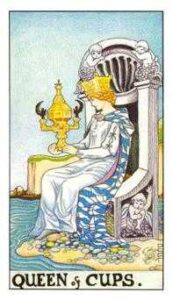 The other day I was on the phone with a regular reader and commenter to this blog. We live only a few hours apart during the summer, and we were trying to arrange to meet halfway in between for lunch. At one point she wondered aloud about the outcome of my inner work. Do I feel better? Wiser? Am I happier? More loving, balanced and spiritually connected than when I began?
The other day I was on the phone with a regular reader and commenter to this blog. We live only a few hours apart during the summer, and we were trying to arrange to meet halfway in between for lunch. At one point she wondered aloud about the outcome of my inner work. Do I feel better? Wiser? Am I happier? More loving, balanced and spiritually connected than when I began?
My immediate response was, and is, “Yes!” But I’m not sure my explanation addressed this deeply sincere seeker’s question. Was she wondering if, as an introvert who has traveled my own way for the last 22 years with very little support from therapists, groups or spiritual guides other than books, I am satisfied with the results? Or was she wondering if determined inner work in general has resulted in my feeling somehow finished? Am I always wise and peaceful? Always emotionally open, balanced, loving and spiritually connected? Perhaps even… enlightened? If she meant the former, my answer is still, “Yes!” But if the latter, it would be an equally emphatic, “No!”
 Sometimes I feel very stupid. Also anxious, emotionally closed, unbalanced, selfish, and judgmental. Certainly not whole or enlightened. Enlightenment is a term I first heard in reference to Eastern religions. Once, the idea drew me forward like a carrot dangling in front of a donkey’s face, but then I discovered Jungian psychology, turned around, and met my Shadow.
Sometimes I feel very stupid. Also anxious, emotionally closed, unbalanced, selfish, and judgmental. Certainly not whole or enlightened. Enlightenment is a term I first heard in reference to Eastern religions. Once, the idea drew me forward like a carrot dangling in front of a donkey’s face, but then I discovered Jungian psychology, turned around, and met my Shadow.
Essentially I find the meaning of my life in soul-making. This is a process, not a final product. Currently I’m reading “Women, Writing, and Soul-Making: Creativity and the Sacred Feminine” by Peggy Tabor Millen. If you’re a woman who writes, I highly recommend her books. Malaprop’s Book Store in Asheville, North Carolina has put us together for a joint presentation on Sept. 21st and I hope you’ll come if you’re in the area. Anyway, with her unique combination of Western and Eastern thought and practice, Millen strives to activate her creativity by balancing her masculine and feminine energies through writing and teaching. She calls this struggle to release her authentic creativity soul-making.
A typical Westerner, Carl Jung approached his soul-making work by strengthening his mind with logic and will-power until his ego-spirit mustered the courage to step aside. This allowed soul to move into consciousness, revealing disowned parts of his psyche. In the process, his unique creativity was released. The East historically begins its quest by quieting the mind and practicing physical austerities aimed at humbling and displacing the ego-spirit. But eventually the same thing happens. Letting go enables spirit to hear and express soul’s deep, compassionate voice.
 For millennia these different approaches were separated by a divide that was geographical, philosophical, religious, spiritual, and psychological. Yet both have always aimed at uniting masculine spirit with feminine matter. As Millin says, the ideal is for both to participate in a cyclical yin/yang flow from one to the other which ensures that when balanced one never dominates, except temporarily.
For millennia these different approaches were separated by a divide that was geographical, philosophical, religious, spiritual, and psychological. Yet both have always aimed at uniting masculine spirit with feminine matter. As Millin says, the ideal is for both to participate in a cyclical yin/yang flow from one to the other which ensures that when balanced one never dominates, except temporarily.
Since the Dalai Lama made his home in the West, these perspectives have begun to merge and overlap. Each of us is discovering a new way to live in a never-ending process of moving first this way, then that, re-inventing ourselves anew every day in a middle way that encompasses both streams. The sacredness of this mandorla way speaks not to where we start or finish our journey, but to our willingness to release the creative flow in our natures with each step.
Has there been a payoff for my form of inner work? Yes indeed. But that says nothing about your form. Eventually, all paths to growth use the same process. The last thing that matters is how we got there.
You can purchase Healing the Sacred Divide at www.larsonpublications.com and www.Amazon.com .While you’re at Amazon, check out the newest review written by Joey Madia.

Living in a Culture That’s Lost Its Heart
“To learn how to fully live Eros makes a major contribution to the world around me, because this is a culture that’s lost its heart;



0 Responses
“Enlightenment is a term I first heard in reference to Eastern religions. Once, the idea drew me forward like a carrot dangling in front of a donkey’s face, but then I discovered Jungian psychology, turned around, and met my Shadow.”
Thus began my road too! I’ve found Shadow work to be intense and rewarding but not so easy. I really enjoy your blog and I find myself nodding my head many times as I read them. I live close to Asheville so I hope to see you at Malaprops. I’m so glad you will be in the area.
I wonder though if you think your journey would have been faster or somehow enhanced by being in analysis?
Hi Linda,
Yes, I do think my journey would have been vastly enhanced if I’d been in analysis. There were no Jungian analysts anywhere near where I lived and I yearned for one for years. I did spend a year with a Jungian-oriented therapist, however, and it helped enormously. The rest I did pretty much on my own, with the help of some extraordinary books…and my dreams. Thanks for your comment. I hope to meet you at Malaprop’s! Jeanie
Journey
Along a shadow-dappled path on a late summer evening, a child and an old man walk discussing many topics of great interest: their favorite painters and poets, the art of brewing tea, water divining, and the ever self-revealing topic of soul-making.
“There is no finish line on that journey,” said the child to the old man.
“Is that why we make everything into a race?” asked the old man, “It would seem we like finish lines.”
“I suppose,” laughed the child, “we all like to imagine and to feel a sense of completion.”
“So it’s OK to want conclusions?”
“Of course, provided you remember that conclusions are just doorways to new beginnings.”
“So nothing ends?”
“Oh things end,” said the child, “just not in the way we’re taught to understand endings. In the movies they flash a big, ‘The End,’ so we know to get up and leave–in case we didn’t know. Everything gets tied up nicely. In reality, however, when something ends, when Enlightenment dawns, when a soul awakens, it often happens after, or during, a not-so tidy experience. Sometimes it’s a little messy, rough around the edges, torn, broken, wrinkled, worn out. But if one looks at our brothers and sisters of the cicada variety and the caterpillar variety, and the hatchling and the tadpole variety; the autumn leaves, late, late evenings like this one, we would see that endings are really wildly transformative and colorful beginnings.”
“I’m not sure I want wildly transformative beginnings.”
“You’re not alone,” said the child, “I am guessing when the cicada nymph’s back splits and its wings spill out that it feels both painful and relieved, much like the scratching of a deep itch. I wonder how it feels to be the caterpillar spinning its own shroud in rhythmic pulsations, and then dissolving into an alchemical substance that will eventually take the shape of a butterfly. Really, think of that a moment—caterpillars dissolve in their cocoons. They liquefy.
What must that be like?”
“A bit like losing oneself in grief, perhaps,” offered the old man.
“Losing oneself into anything you love,” said the child, “Tears and heart-softening embraces happen when we’re happy or sad. My point is it’s probably a difficult transition—from fully-bellied, exhausted caterpillar to churning, golden liquid; to deep dreaming; to powdery winged enlightenment.”
“Did you know that the word ‘chrysalis’ comes from the Greek, ‘khrysos,’ meaning gold?”
“I did know that,” said the child, “thank you for reminding me. The whole enlightenment process, even the difficult parts where we seeming lose ourselves—is golden.”
“Maybe we like finish lines because we get to rest, or because we imagine the pain and hard work will be over?”
“Something like that,” said the child, “if we actually learn to settle into periods of rest and inactivity, so-called ‘endings’ wouldn’t come as undesirable surprises. After all, the tide comes in and the tide recedes. The morning dawns and the night awakens. The body slips into the harbor of sleep and rises with the songbirds to work the fields. Endings are the shadows of beginnings. Enlightenment is the sister of darkness.”
“It would seem a healthy practice then to enjoy the journey,” said the old man.
“Yes!” shouted the child happily, “That’s the key. Allow yourself to be blessed by the very path itself, and by the walking and the movement, the rest times, and the dancing. Allow yourself to revel in the ability to move and to learn, to be able to stumble and rise again. This gratitude opens all doors at the so-called end of the road. And when one steps through the gates they find themselves in a mansion that is really a universe; that is really one world within another, one body of light giving way to other bodies of light; there are rooms within rooms in the mansion of heaven, souls within souls, embraces within embraces. The valleys rise and the mountains bow. Beds are carried on currents of dreams, and dreams spill over into kitchens and living rooms, classrooms and churches. New myths are told and stories bloom in the minds and hearts of children. Gardens break forth into gardens, caresses drip into caresses, desires are fulfilled only to give birth to children named, “Gratitude,” “Prosperity,” “Success.” And then these go out into the world to play only to discover entirely new cities and open new gates, enter new heavens, explore new forests. Yes, enjoy the journey,” said the child, “and know that enjoying the journey means sometimes you will stumble, fall, want to give up. That’s all a part of it. We do grow tired and weary sometimes. Enlightenment doesn’t necessarily mean boundless energy; it just means there’s clearer light to see where to go next.”
“What do we do when we grow tired and weary?” asked the old man.
“Rest,” said the child, “Pause. Breathe. Allow yourself to dissolve into doing nothing, stop where you are on the dance floor and rest your head against the shoulder of your partner. Let them glide you along.”
“So part of the journey is resting.”
“Yes. And part of the journey is learning to live with incompleteness and imperfections. Think of the tadpole when it’s close to becoming a frog. It still has a tail. And it probably doesn’t try to hide it like we might. But it belongs to two worlds—the fish and the frog. It has a sort of identity crisis, only it probably isn’t a crisis because it simply accepts this temporary tail as part of the plan. We’d probably feel embarrassed at not quite being fully frog; we would think we’re not enlightened until we lost our tail.”
“You’re saying the journey is imperfect?”
“No, the journey is perfect. It’s just that we walk it imperfectly, which in the grand scheme of things, is perfect anyway, just as the clouds look all jumbled and yet somehow manage to look beautiful as they travel across the sky. We are enlightened here and now, it’s just that we think too much about what that means and the experience gets lost in ideas and expectations.”
“Let me try and sum this up,” said the old man.
“OK,” laughed the child.
“There is no finish line to the journey of life, to enlightenment. There are pauses, deep breaths, transformations, rest stops, but no actual endings. Endings are beginnings with different names. They’re twins. Also, we cannot travel the road perfectly. We will stumble sometimes or get caught with our tails still showing. But in the end…”
“That’s a pun,” interrupted the child.
“Oh dear,” laughed the old man, “So it is. In the end, or at the end of the day, whatever we call it, the night comes, our own cosmic cocoon descends, and we dissolve into sleep and dreams only to wake up the next morning, born again, refreshed, renewed, transformed, and ready for more.”
“Sounds good to me,” said the child, “and there’s one more thing about the journey that is perhaps the most important thing of all.”
“What’s that?”
And as the old man waits for an answer, the child slips his hand into his.
“We go together,” said the child, “the journey is shared. It belongs to us all. We can only walk alone so far. We all need to be carried sometimes and we all need to carry others. And when we reach those views, those heavenly plateaus, they are heavenly precisely because we are sharing them with others. Heaven is heaven because it is the coming together of people and loves, desires and dreams—all spilling into one ocean, one song, one dazzling and exquisite embrace.”
“I like that,” said the old man, “thank you for going with me.”
And as they continued walking deep into the night, the moon untangled herself from the trees and drifted easily into view. The sun tucked his face gently into the bosom of the night, and the child turned to the old man and smiled. It was the smile of the future and of endless beginnings.
You’ve done it again, Joseph. I always marvel at the Beauty and wisdom of your stories. Thank you for sharing them here. My favorite line in this one is, “Enlightenment doesn’t necessarily mean boundless energy; it just means there’s clearer light to see where to go next.” I think that’s very wise, indeed! Thank you for being a companion on my journey. Jeanie
ahhh…that is it Joseph! …thanks for sharing this story…it all resonated and ….”it is all golden” (the hits, the misses, the light, the dark, the breakdown, the pause, the rest, the enlightenment, the renewal, etc. etc. etc.)! This story gave words and shape to how I feel and to my experience. Thank you Joseph for sharing through your story!
Thanks for your sharing too Jeanie.
I feel and experience the “shared journey”! That is a gift!
Gratefully, Sandy
It is, indeed, Sandy! And thanks to you too for being a companion on my journey! Jeanie
This is really lovely!
Thank you, Skip!
At the risk of overwhelming [though this will be a simplistic comment], I’d like to mention how all of this fits together with Calculus, as a tool to show something relevant about why finding Soul/Wholeness/Enligtenment is so difficult for everyone. It is quite right that you used the symbols for yin-yang, as Dr. Jung spoke often about circumambulation, notably in his commentary to “The Secret of the Golden Flower,” which is available online.
In Psychology of the Unconscious (which is now available as an audio book, thankfully), Dr. Jung explained that all beings, at least animal and vegetable, know how to become what they are. An Oak tree becomes an Oak, and not a Maple. A Siamese cat becomes a Siamese cat, and not a Tiger and not a Pine tree.
Human beings are just like that. We all have within us the ingredients to become a Soulful human being. But there are literally millions of scales (pairs of opposites) to that. Not too much and not too little, but just right in the context of all of the other scales. The Siamese paw becomes not too little not too big, but just right for a Siamese. But individual Soul/Wholeness is about the fact that no two Siamese paws are the same. We often think of human faces as being all different, but the truth is that every part of us is different. All of our systems know how to make every human body part, but every single one of them makes each of those body parts slightly differently–even in identical twins.
I’ll take slight exception to the idea that the Soul is “Halfway in Between”. Dr. Jung spoke of many scales, but taking the simplest we can think of Extrovert and Introvert. Each of us falls somewhere on that scale, but none just perfectly in the middle, and we’re always moving along that scale one way or another depending on the situation. In human beings, there are literally millions of scales, and Soul or Wholeness for the individual involves reaching as closely as possible to the right balance of all of those for each individual.
As a mathmatician would tell you, Soul is a point (or a mandorla perhaps) on a curved line in hyperspace (that’s the simplistic description of calculus). Let us suppose, for the sake of understanding, that there two of us, and one of us has 10 apples and one has 10 oranges. If we graphed this, we could show that one would trade 4 apples for 4 oranges and the other would do the reverse, and both would be happy. This can be easily shown on a two dimensional graph, which would look very much like Jean’s Mandorla, with the center circle being the region in which both parties are happy enough with the exchange. If there were three of us with apples, oranges, and bananas, we could still show the intersection of happiness (Wholeness/Soul Satisfaction) on a three dimensional graph.
BUT, now let’s suppose that there are 4 of us, and each has 10 fruits in differing quantities: apples, oranges, bananas and peaches. You can easily see how this 4 dimensional situation can no longer be graphed, as we only use three dimensions plus time, notwithstanding the fact that by trading back and forth we could reach a point of relative happiness (“Wholeness”), where we are satisfied enough with the number of each fruit we have, given that there were only 40 items in total. We simply could not graph the result (which is my metaphor for finding Soul/Wholeness).
This is where Calculus comes in, because each time we add a variable, like peaches, we add another dimension–in what we call hyperspace. Supercomputers can easily handle 300 or even 3,000 dimensions, but the reason we still get bad weather forecasts is that they cannot handle all of the calculations that could be entered from every data collection point fast enough, and there aren’t enough data collection points, nor is there enough information about what can happen under every possible situation. Human beings are even more complex than the weather, so no wonder it is so difficult to describe Soul/Wholeness/Enlightenment for any one of us. It is different for each of us.
SO, to make a long story short, it is about the Journey, not the destination, which can never be reached (because as soon as you reached equilibrium on all scales, someone or something would turn the kaleidoscope and change the destination once again). In Joseph’s illustration above, which I acknowledge is lovely and brilliant, you would need an infinite number of participants to close in on what’s actually happening in the psyche as we do our inner work. Yes, there are big categories like masculine and feminine, but even those have many shades.
It seems to me that, as thoughtful people [which all of you are who got to this point in this comment], we would do well to give a nod to the complexity of the task as we inevitably bite off a piece of the apple to find our way to our Soul, which is inevitably a moving target.
Wow! That’s a lot of apples and oranges! Thanks for the very clear and affirming explanation. I never took calculus, stopped at trigonometry, so had no idea what it’s about. I loved the analogy to the weather forecast. So yes, let’s indeed give a nod to the complexity of the task, and, in so doing, give ourselves a break for having such a difficult time figuring it all out as we keep moving, step-by-step, toward our inner moving target. Thanks, Skip. Jeanie
Yes, I am giving a definite “nod to the complexity of the task” and to this comment…thanks Skip! Very interesting and an additional piece of understanding our inner moving puzzle (target)! Sandy
Hi Jeanie,
Logic and intellect, when used honestly I think, bring us to a certain point where we can then confront the “bisexual” nature of the personality and begin to learn about the other side. The constant questioning strengthens consciousness for this unending task — one of the reasons individuation is not really understood or condoned. When you begin to think about and doubt what you do, the collective senses you as a problem which might interfere with its program. Following your own program only makes sense to those who have been inwardly compelled — like you. Enjoyed this post, thank you.
Evan
Hi Even,
Yes, the way of constantly questioning oneself and the meaning of one’s life most certainly does not make for a lot of fans. The collective wants to know the answers, and we look up to those who profess to have them, even when in our guts we know they can’t possibly! But we just don’t want to hear it. I think that’s what Jesus meant when he said that only those with eyes to see and ears to hear would understand his message. He knew most of us don’t want to see or hear the truth….we just can’t help it; our fears simply have too strong a grip on us….unless we’ve somehow been inwardly compelled, in which case we really have no choice. Well said! Thanks.
Jeanie
We have no choice! But who having discovered that would turn back time and disavow that choice which was no choice? A difficult maneuver for the intellect, not so much for the emotion.
Yes, the ego/spirit resists what challenges its importance; the body/soul welcomes truth. All of us are burdened with that never-ending conflict.
Wow, this continues to be a thoughtful and rich dialogue! Thank you Evan and Jeanie (and Linda)! Nutritious food for the soul! Sandy
So are we creating a new soul diet? Rich and nutritious at the same time? Sounds delicious to me! 🙂 Jeanie
Yes! 🙂 and it sure does sound delicious to me too! Yummmm
Me too!